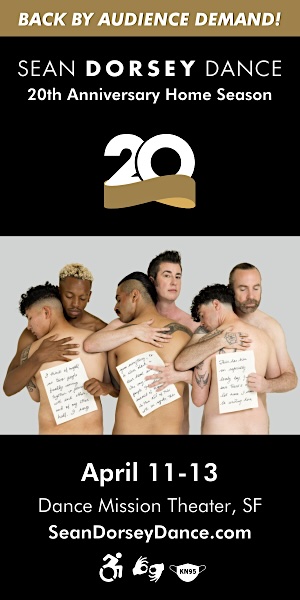SCREEN GRABS Last call for those interested in saving the Opera Plaza Cinemas, whose four arthouse screens are at high risk of being exterminated for whatever trendier, higher-rent-paying retail project San Francisco doesn’t need more of at present. The SF Planning Commission will have an open hearing on the matter this Thursday at City Hall, 1pm. So if you place some value on what remains of the city’s rapidly vanishing non-mainstream film culture, please attend and make yourself heard.
As it happens, it’s a good week to appreciate those remaining alternatives to Avengers XIX & co. There’s not much new at the multiplex beyond yet another reboot of the Predator franchise—has anyone ever actually found those frequently-invisible Space Alien Rastamen scary?—and the potentially interesting White Boy Rick, a fact-based crime story whose screenplay was co-written by Bay Area twins Logan and Noah Miller.
You may also wasn’t to check out the varied offerings of the Cine+Mas Latino Film Fest, happening around the Bay, including “Have You Seen Her, La Misión?” at the Roxie, a collection of films that “showcases the varied responses to the transformations experienced in the Mission District during the late 1990s dot.com boom.”
On the arthouse beat, there are three new documentaries: Inventing Tomorrow, Laura Nix’s look at look at teenage innovators working to salvage their own environmental future around the world; Heather Lenz’s Kusama: Infinity, a portrait of 88-year-old Japanese artist Yayoi Kusama’s long struggle toward her current, fabulously successful status; and American Chaos, in which filmmaker Jim Stern puzzles out the appeal of The Donald by interviewing heartland supporters during the Presidential campaign two years ago. (These are all opening Friday at Landmark Theaters, see www.landmarktheatres,com for details.)
The most interesting offerings this week, however, lie more in the realm of cinematheque retrospectives and one-off revivals or other events:
LUCHINO VISCONTI: CINEMA OF STRUGGLE AND SPLENDOR It’s impossible now to imagine a filmmaker of equal extravagance and idiosyncrasy having the kind of major international career that aristocratically born Visconti managed over about three decades’ course, until his death in 1976. (Some might Luca Guadagnino as his artistic heir, but it’s way too early to tell if he merits the comparison beyond a shared interest in pretty, privileged people in luxurious settings.)
The Milanese theater, opera and film director worked as an assistant to Jean Renoir before making his own screen debut with 1943’s Ossessione, an unacknowledged adaptation of amour fou classic The Postman Always Rings Twice. It helped kickstart the Italian neo-realist school, which he stuck with until 1954’s Senso, another tale of romantic obsession—but this one a lavish period piece. Visconti’s films grew more and more ambitious, from the epic melodrama of classics Rocco and His Brothers and The Leopard to such glacially paced costume extravaganzas as The Damned, Death in Venice and Ludwig.
An “out” gay man with both Communist sympathies and a privileged aesthete’s sensibility, his was a unique and uncompromising creative vision even when it misjudged. (He was not, for instance, the right man to adapt Camus’ The Stranger.) This touring retrospective includes nearly all of his features, shown in imported 35mm prints. Fri/14-November 30, Pacific Film Archive. More info here.
FREDERICK WISEMAN: ON DOCUMENTARY
The PFA is saluting another master with a much shorter retrospective beginning this week, and the contrast couldn’t be sharper: Wiseman is the ultimate invisible observer, training his camera on various institutional subjects in a seemingly passive, neutral way that nonetheless invariably adds up to tremendous insight.
He began in 1967 with the notorious Titicut Follies—a look at a Massachusetts government mental institution that proved so shocking the state succeeded in having it legally banned from exhibition for decades. His next film was the equally controversial High School (1969), which underlined the “generation gap” in society at the height of Vietnam War protests. It will be included in this brief series, along with three more recent verite studies: Belfast, Maine (1999), examining everyday life in a small American seaside town; and two self-explanatory looks at major cultural institutions, La Danse: The Paris Opera Ballet (2009) and Ex Libris: The New York Public Library (2017).
Now 88, Wiseman will not only appear at the PFA Thurs/27 to lecture on the documentary form, he also has a new documentary (Monrovia, Indiana, another small town pulse-taking, this time during the Trump era) premiering this month at the Toronto Film Festival. Thurs/13-Sun/30, PFA. More info here.
GREATEST HITS OF THE SILENT ERA WITH CLUB FOOT ORCHESTRA
A beloved San Francisco club act that found its most popular forum when they started composing and playing live scores for silent films, Club Foot Orchestra is celebrating over three decades of that pursuit (and a 35-year overall history) with this marathon Castro Theater event. It will provide not just an orgy of musical invention, but a one-day encapsulation of some of the greatest silent cinema ever.
Things kick off with a comedy program of Buster Keaton and Felix the Cat shorts. Then we’ll made into heady realms of German Expressionism and nightmarish fantasy with Robert Weine’s 1920 The Cabinet of Dr. Caligari, Fritz Lang’s 1927 dystopian sci-fi epic Metropolis (shown in its restored 148-minute version), and F.W. Murnau’s 1922 vampire thriller Nosferatu. Sat/15, Castro Theater. More info here.
NOSFERATU THE VAMPYRE
Perhaps by coincidence, the Alamo Drafthouse is also offering a rare revival of Werner Herzog’s 1979 remake of the Murnau film, which it closely follows while adding considerable new beauty both visual and sonic (Popul Vuh created the original score). The inimitable Klaus Kinski was ideally cast as Count Dracula—this version was able to use character names from Bram Stoker’s novel, where the earlier one was sued for stealing his ideas without credit—with Isabelle Adjani and Bruno Ganz as the lovers he imperils. The slowly paced but haunting color re-imagining of a silent classic was not well received in English-dubbed form, but was successful in Europe, and gradually acquired a cult folllowing in the U.S. Tues/18, Alamo Drafthouse. More info here.
POOR LITTLE RICH GIRL
Also making a rare screen appearance this week is Andy Warhol’s 1965 feature, one of several he made around that time starring his then-muse, young Manhattan socialite Edie Sedgwick. She’s first blurrily glimpsed in bed; her first words upon waking (among the few intelligible ones here) are “Fuck you.” For 66 minutes she lolls around her room in bra and panties, talking to offscreen friend/promoter Chuck Wein, listening to the Everly Brothers and then The Shirelles, trying on clothes and piling on makeup.
Five years later she’d be dead of a barbiturate overdose, still under 30. As with many in the Warhol “Factory” scene, that premature end end only heightened her tragic glamour. Named after the 1936 Shirley Temple movie that was Andy’s childhood favorite, Poor Little Rich Girl is a real test of patience—not only does “nothing happen,” but technical problems involving a faulty lens resulted in the entire first reel being out-of-focus. (This prompted Warhol to shoot more, in-focus footage, but not to scrap the material already in the can.)
Nonetheless, it affords a gander at Sedgwick’s vivacious personality, which endeared her to her gay Svengali until they had a falling out from which they (and her “career”) never recovered. It’s a weirdly prescient artifact: Expecting us to adore her simply for being on-camera, Edie is a sort of proto-Kardashian, aspiring towards “famous for being famous,” and this film is a B&W 16mm version of the selfie. Wed/19, Pacific Film Archive. More info here.
GREASE 2
Last and probably least, the Alamo is offering a chance to wallow in the wonkiness of this 1982 flop, a belated quasi-sequel to the 1978 smash hit (in turn based on a Broadway musical). John Travolta and Olivia Newton-John couldn’t be induced to return to their original roles, so newcomers Maxwell Caulfield and Michelle Pfeiffer were drafted for equivalent roles. (Upon release, it seemed the film would be the death-knell for both their careers, but Pfeiffer soon rebounded with Scarface.)
Choreographer Patricia Birch was hired to direct—for the first and last time—a decision that proved only marginally less wrong-headed than producer Allan Carr’s hiring of veteran comic Nancy Walker to direct the Village People musical Can’t Stop the Music two years earlier. Its cast stuffed with old-school celebrities like Connie Stevens, Tab Hunter, Sid Ceasar and Eve Arden, its soundtrack cluttered with clunky new songs, Grease 2 did not make lightning strike twice at the box-office. But somehow it has become a kind of cult favorite—weirdly, primarily among viewers raised on High School Musical and its sequels. Tues/18, Alamo Drafthouse. More info here.






